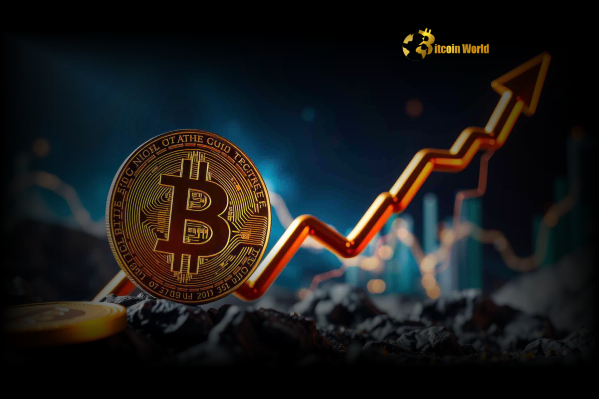BitcoinWorld

Bitcoin Miners Face Pressure: Shocking Sell-Off Hits Record Despite BTC Price ATH
The world of Bitcoin mining is rarely simple, and recent data reveals a surprising trend that might make you look twice, especially given the celebratory mood around Bitcoin’s recent price surge. Despite Bitcoin (BTC) hitting a new all-time high (ATH) around $73,000 in March and hovering at elevated levels in April, a significant shift occurred behind the scenes: Bitcoin miners sold off a record portion of their reserves.
According to analysis by TheMinerMag, as cited by CoinDesk, Bitcoin miners offloaded approximately 115% of the Bitcoin they mined in April. Think about that for a moment – they sold more BTC than they produced during the month. This marks the highest sell-off rate observed since late 2022, a period characterized by significant market downturns and financial stress for miners. This action by Bitcoin miners presents a complex picture for the broader crypto market.
Why Are Bitcoin Miners Selling So Much BTC Despite the Price Rise?
At first glance, it seems counterintuitive. If the BTC price is high, shouldn’t miners be enjoying massive profits and holding onto their newly minted coins? The reality is more nuanced and points to underlying pressures within the Bitcoin mining industry. Two primary factors are driving this aggressive selling:
- Weak Hashprice: Hashprice is a metric that measures the expected revenue a miner can earn from a given amount of hashing power (measured in terahashes per second, TH/s) per day. It’s calculated based on the current BTC price, the block reward, and the network difficulty. While the BTC price was high, other factors eroded the profitability per unit of hash power.
- High Network Difficulty: Bitcoin’s network difficulty adjusts roughly every two weeks to ensure that blocks are mined at a consistent pace (approximately every 10 minutes). As more miners join the network and deploy more powerful hardware, the difficulty increases. This means individual miners need more hashing power to find a block and earn the reward. The network difficulty has been on a general upward trend, making it harder and more expensive to mine Bitcoin.
The combination of relatively weak hashprice (compared to peak bull market euphoria) and high network difficulty translates directly into lower revenue per unit of mining power. This financial squeeze means that even with a high BTC price, miners are earning less Bitcoin for the same operational cost (primarily electricity). To cover these costs, service debt, fund expansion, or simply maintain liquidity, many miners are forced to sell a larger percentage of their mined Bitcoin, and in some cases, dip into their existing reserves.
Understanding the Economics of Bitcoin Mining and Hashprice
To fully grasp the situation, let’s break down the key economic drivers for Bitcoin miners:
Miners incur significant costs, regardless of the BTC price or network difficulty:
- Electricity: This is typically the largest operational expense. Miners consume vast amounts of energy to run their hardware.
- Hardware (ASICs): High-performance mining machines are expensive to purchase and require regular upgrades to remain competitive.
- Infrastructure: Building and maintaining mining facilities, including cooling systems and security.
- Personnel & Overhead: Staffing, management, and administrative costs.
- Debt Financing: Many large mining operations take on debt to purchase hardware or build facilities, requiring regular interest and principal payments.
Miner revenue comes primarily from two sources: the block reward (newly minted BTC) and transaction fees. The block reward is fixed (currently 3.125 BTC after the April 2024 halving) and decreases over time. Transaction fees vary based on network activity. Hashprice essentially aggregates these revenue streams and divides it by the total network hash rate to give a per-unit profitability metric.
When network difficulty rises faster than the BTC price, or when transaction fees are low, the hashprice declines. A declining hashprice puts pressure on less efficient or highly leveraged miners, making it harder for them to cover their fixed costs. Selling mined Bitcoin becomes a necessity to stay afloat, even if they believe the price will rise further in the future.
The Contradiction: Sell-Offs and Expansion in Bitcoin Mining
One of the interesting paradoxes highlighted in the report is that while many miners are selling aggressively, major mining firms continue to announce expansion plans and strike deals for new, more efficient hardware. How can both be true?
This suggests a widening gap between different types of Bitcoin miners:
- Less Efficient / Higher Cost Miners: These operations, perhaps with older hardware, higher electricity rates, or significant debt, are feeling the pinch the most. They are forced to sell a large portion, or even all, of their mined BTC just to cover operational expenses and debt obligations. This group likely contributes heavily to the 115% sell-off figure.
- More Efficient / Well-Funded Miners: Larger, publicly traded companies often have access to cheaper electricity, newer hardware, and various financing options (equity raises, debt, strategic partnerships). They may be able to continue expanding, viewing periods of stress as opportunities to gain market share as less competitive miners drop off. They might be financing new hardware deals using existing BTC reserves, taking on new debt, or raising capital, which also requires strategic selling or asset utilization.
The fact that some major players are still expanding indicates a long-term bullish outlook on the crypto market and the future profitability of Bitcoin mining, despite the current short-term pressures. They are essentially betting that future hashprice will be high enough to justify the significant upfront investment in new hardware and infrastructure.
What Does This Record Miner Sell-Off Mean for the Crypto Market?
Miner selling is one component of the overall supply dynamics in the crypto market. While a 115% sell-off rate sounds dramatic, it’s important to put it into context. Miners produce a relatively small percentage of the total daily Bitcoin trading volume. However, consistent selling pressure from this group can still have an impact, especially during periods of lower liquidity.
Historically, miner behavior has sometimes been interpreted as a sentiment indicator. Aggressive selling can signal that even those closest to the production of Bitcoin are facing financial stress or potentially taking profits. Conversely, holding or accumulating BTC suggests confidence in future price appreciation.
The current situation suggests that while retail and institutional demand might be pushing the BTC price up, there’s a consistent source of supply coming from miners needing to cover costs. This could act as a short-term dampener on extreme price rallies or contribute to price consolidation.
It also highlights the increasing industrialization of Bitcoin mining. The days of individual enthusiasts mining profitably on basic hardware are largely over. The industry is dominated by large, sophisticated operations with significant capital requirements and operational complexities.
Looking Ahead: Challenges and Opportunities for Bitcoin Miners
The coming months present both challenges and opportunities for Bitcoin miners. The recent halving event cut the block reward in half, instantly doubling the pressure on hashprice (unless transaction fees or the BTC price rise significantly to compensate). This will likely exacerbate the divide between efficient and inefficient miners.
Potential scenarios include:
- Miner Consolidation: Less profitable miners may be forced to shut down operations or be acquired by larger players.
- Increased Focus on Efficiency: Miners will prioritize securing the most energy-efficient hardware and finding the cheapest sources of electricity.
- Diversification: Some mining companies are exploring revenue streams beyond just block rewards, such as providing hosting services, mining other cryptocurrencies, or utilizing waste heat.
- Impact of Future Price Action: Ultimately, a sustained significant increase in the BTC price is the most direct way to improve miner profitability and reduce the need for aggressive selling.
For observers of the crypto market, monitoring miner behavior, network difficulty, and hashprice provides valuable insights into the underlying health and economics of the Bitcoin network. While the 115% sell-off figure is notable, it’s a symptom of the competitive and challenging environment miners face, particularly after the halving.
Conclusion: A Stress Test for Bitcoin Mining
The report revealing Bitcoin miners selling 115% of their April production, the highest rate since late 2022, is a stark reminder that a high BTC price doesn’t automatically equate to easy profits for everyone in the ecosystem. Pressures from high network difficulty and relatively weak hashprice are forcing miners to liquidate reserves to cover operational costs and debt, even as some major players continue to expand.
This situation represents a stress test for the Bitcoin mining industry, likely accelerating consolidation and driving innovation in efficiency. While miner selling adds a layer of supply to the crypto market, its long-term impact will depend on overall market demand and the future trajectory of Bitcoin’s price and network fundamentals. Keeping an eye on miner metrics is crucial for understanding the complex forces at play in the Bitcoin ecosystem.
To learn more about the latest crypto market trends, explore our article on key developments shaping Bitcoin price action.
This post Bitcoin Miners Face Pressure: Shocking Sell-Off Hits Record Despite BTC Price ATH first appeared on BitcoinWorld and is written by Editorial Team





